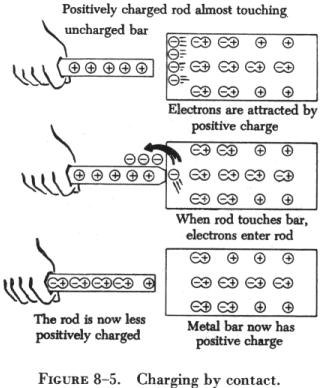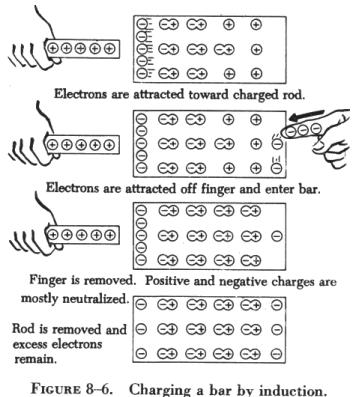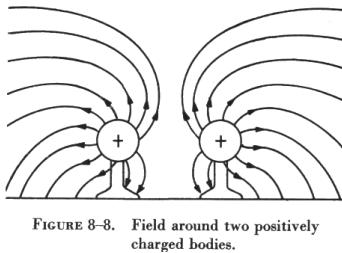STATICELECTRICITY
STATIC ELECTRICITY
Electricity is often described as being either static or dynamic. Since
all electrons are alike, these words do not actually describe two different
types of electricity; rather, they distinguish between electrons at rest
and those in motion. The word static means "stationary" or "at rest," and
refers to the deficiency or to the excess of electrons. Originally it was
thought that static electricity was electricity at rest because electrical
energy produced by friction did not move. A simple experiment, such as
running a dry comb through hair, will produce cracking or popping sounds,
indicating static discharges are taking place. The charges thus built up
consist of electrons transferred to the comb as the result of friction.
The discharge is caused by the rapid movement of electrons in the opposite
direction from the comb to the hair as the charges neutralize each other.
In the dark it is possible to see these discharges as tiny sparks.
Static electricity has little practical value, and often causes problems.
It is difficult to control and discharges quickly. Conversely, dynamic,
or current electricity, is generated and controlled easily and provides
energy for useful work.
A summary of that part of the electron theory dealing with charges will
help explain static electricity. All electrons are alike and repel each
other. Similarly, all protons are alike and repel each other. Electrons
and protons are not alike, but attract each other. Hence, the fundamental
law of electricity is that like charges repel and unlike charges attract.
Generation of Static Electricity
Static electricity can be produced by contact, friction, or induction.
As an example of the friction method, a glass rod rubbed with fur becomes
negatively charged, but if rubbed with silk, becomes positively charged.
Some materials that build up static electricity easily are flannel, silk,
rayon, amber, hard rubber, and glass.
When two materials are rubbed together, some electron orbits of atoms
in one material may cross the orbits or shells of the other, and one material
may give up electrons to the other. The transferred electrons are those
in the outer shells or orbits and are called free electrons.
| When a glass rod is rubbed with silk, the glass rod gives
up electrons and becomes positively charged. The silk becomes negatively
charged since it now has excess electrons. The source of these electric
charges is friction. This charged glass rod may be used to charge other
substances. For example, if two pith balls are suspended, as shown in figure
8-4, and each ball is touched with the charged glass rod, some of the
charge from the rod is transferred to the balls. The balls now have similar
charges and, consequently, repel each other as shown in part B of figure
8-4. If a plastic rod is rubbed with fur, it becomes negatively charged
and the fur is positively charged. By touching each ball with these differently
charged sources, the balls obtain opposite charges and attract each other
as shown in part C of figure 8-4.
Although most objects become charged with static electricity by means
of friction, a charged substance can also influence objects near it by
contact. This is illustrated in figure 8-5. If a positively charged rod
touches an uncharged metal bar, it will draw electrons from the uncharged
bar to the point of contact. Some electrons will enter the rod, leaving
the metal bar with a deficiency of electrons (positively charged) and making
the rod less positive than it was or, perhaps, even neutralizing its charge
completely. |

|
 |
A method of charging a metal bar by induction is demonstrated
in figure 8-6. A positively charged rod is brought near, but does not touch,
an uncharged metal bar. Electrons in the metal bar are attracted to the
end of the bar nearest the positively charged rod, leaving a deficiency
of electrons at the opposite end of the bar. If this positively charged
end is touched by a neutral object, electrons will flow into the metal
bar and neutralize the charge. The metal bar is left with an overall excess
of electrons.
Electrostatic Field
A field of force exists around a charged body. This field is an electrostatic
field (sometimes called a dielectric field) and is represented by lines
extending in all directions from the charged body and terminating where
there is an equal and opposite charge.
To explain the action of an electrostatic field, lines are used to represent
the direction and intensity of the electric field of force. As illustrated
in figure 8-7, the intensity of the field is indicated
by the number of lines per unit area, and the direction is shown by arrowheads
on the lines pointing in the direction in which a small test charge would
move or tend to move if acted upon by the field of force. |
| Either a positive or negative test charge can be used,
but it has been arbitrarily agreed that a small positive charge will always
be used in determining the direction of the field. Thus, the direction
of the field around a positive charge is always away from the charge, as
shown in figure 8-7, because a positive test charge
would be repelled. On the other hand, the direction of the lines about
a negative charge is toward the charge, since a positive test charge is
attracted toward it.
Figure 8-8 illustrates the field around bodies having like charges.
Positive charges are shown, but regardless of the type of charge, the lines
of force would repel each other if the charges were alike. The lines terminate
on material objects and always extend from a positive charge to a negative
charge. These lines are imaginary lines used to show the direction a real
force takes. |

|
 |
It is important to know how a charge is distributed on an object. Figure
8-9 shows a small metal disk on which a concentrated negative charge has
been placed. By using an electrostatic detector, it can be shown that the
charge is spread evenly over the entire surface of the disk. Since the
metal disk provides uniform resistance everywhere on its surface, the mutual
repulsion of electrons will result in an even distribution over the entire
surface. |
Another example, shown in figure 8-10, is the
charge on a hollow sphere. Although the sphere is made of conducting material,
the charge is evenly distributed over the outside surface. The inner surface
is completely neutral. This phenomenon is used to safeguard operating personnel
of the large Van de Graaff static generators used for atom smashing. The
safest area for the operators is inside the large sphere, where millions
of volts are being generated.
| The distribution of the charge on an irregularly shaped object differs
from that on a regularly shaped object. Figure 8-11 shows that the charge
on such objects is not evenly distributed. The greatest charge is at the
points, or areas of sharpest curvature, of the objects.
The effects of static electricity must be considered in the operation
and maintenance of aircraft. Static interference in the aircraft communication
systems and the static charge created by the aircraft's movement through
the air are examples of problems created by static electricity. Parts of
the aircraft must be "bonded" or joined together to provide a low resistance
(or easy) path for static discharge, and radio parts must be shielded.
Static charges must be considered in the refueling of the aircraft to prevent
possible igniting of the fuel, and provision must be made to ground the
aircraft structure, either by static conducting tires or by a grounding
wire. |

|




